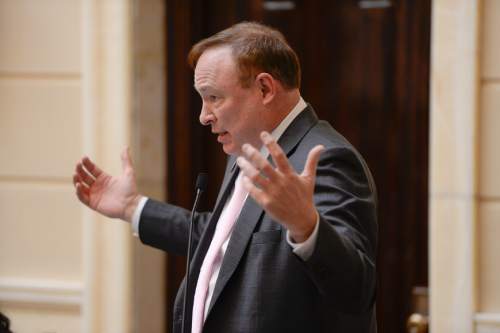This is an archived article that was published on sltrib.com in 2016, and information in the article may be outdated. It is provided only for personal research purposes and may not be reprinted.
Utah's Constitution requires that revenue from the state's income tax be spent supporting public education. And in 1996, that constitutional mandate was broadened to include Utah's public colleges and universities.
But one state senator hopes to undo that change, arguing that elementary, middle and high schools would benefit from hundreds of millions of additional dollars each year if not for the revenue split between public and higher education.
When lawmakers passed the 1996 amendment, according to Sen. Jim Dabakis, D-Salt Lake City, they guaranteed Utah schools would have the largest classrooms and lowest per-pupil funding in the country.
"What they did in the mid-'90s was they stole generational money from our K-12 school children and pretended like everything was fine," Dabakis said.
Dabakis is sponsoring a constitutional amendment that would repeal the 1996 change, leaving only the public education system as a beneficiary of income tax revenue.
He said both education systems deserve more resources, but tying them together gave lawmakers the political cover to fund other priorities while schools competed for limited income tax resources.
"Poll after poll says education is the most important issue for Utahns," Dabakis said. "Like lemmings, we are marching our children off a cliff because the Legislature really doesn't support education."
David Buhler, Utah's commissioner of higher education, served in the Senate at the time of the 1996 vote. He said it is appropriate that Utah's colleges and universities be supported by income tax revenue.
"It is only logical if you have an Education Fund that you would use it to fund education," he said. "And that includes public higher education."
In 1996, the school fund was the fastest growing state fund, having doubled in the preceding decade. Proponents of the change argued that explicitly allowing income tax revenue to support higher education would give state budgeting more flexibility and efficiency.
Then-University of Utah President Arthur K. Smith said without the change, higher education expected to have an increasingly hard time competing for General Fund money because of commitments the state had made toward the reconstruction of Interstate 15.
Critics worried about sharing access to income tax revenues with higher education, particularly in an economic downturn, fearing it could become a "riptide in disguise" for children in grades K-12.
Last year, higher education received 68 percent of its public funding, or roughly $580 million, from the Education Fund, Buhler said.
If colleges and universities were excluded from income tax revenue, he said, that money would need to come from the state's General Fund or a significant increase in tuition costs.
"To hold us harmless is a lot of money," Buhler said. "But it only represents 14 percent of all state education funds."
Dabakis suggested lawmakers could generate revenue for higher education by changing the state tax code, particularly by repealing the flat tax enacted when Jon Huntsman Jr. was governor.
Limiting income tax revenue to K-12 education, he said, would force definitive steps in support of schools, rather than the current practice of incremental funding increases each year.
"This is a big challenge to the people of the state of Utah and the Legislature," Dabakis said.
Prior to being enacted, Dabakis' amendment would need to secure a two-thirds vote in both the House and Senate as well as majority support in a public vote.
Twitter: @bjaminwood



